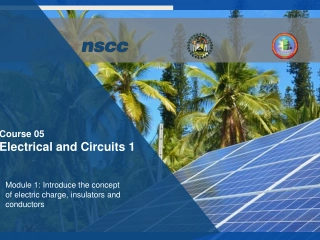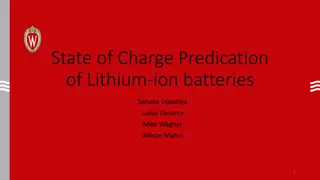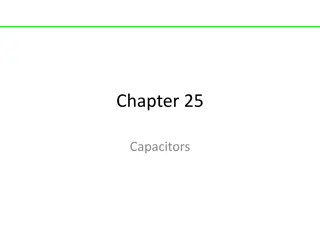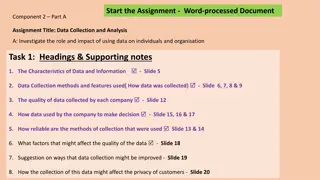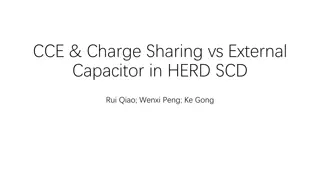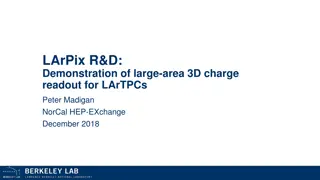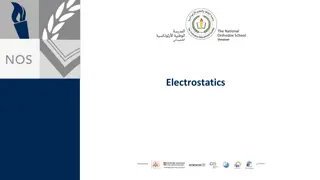Electrical and Circuits 1
Electric charge, insulators, conductors, and electrical flow through materials. Understand static electricity and examples of static charge uses. Discover the concept of insulators with analogies and examples.
0 views • 26 slides
Comparative Analysis of Positive Charge's Charging Stations Evolution
This PowerPoint template example created by Romy Bailey for Positive Charge showcases a comparative study of high-speed charging stations versus traditional charging stations, along with a comparison of past year versus current year data, and a year-over-year analysis of Positive Charge's growth. It
1 views • 6 slides
Positive Charge Annual Marketing Report Highlights
Positive Charge has emerged as a key player in the EV charging industry, showcasing growth in brand awareness and sales through targeted marketing efforts. The report outlines successful project deliveries, partnerships, and sustainability initiatives, setting a promising trajectory for the future.
0 views • 7 slides
Positive Charge Marketing Process Implementation Plan
This marketing process implementation plan outlines the phased approach for Positive Charge, focusing on research & analysis, strategy development, execution & deployment, and monitoring & optimization. Tasks include identifying target cities, evaluating brand perception, setting KPIs, launching edu
0 views • 7 slides
Understanding Electricity and Circuits: A Comprehensive Overview
Explore the fundamentals of electricity, circuits, and energy in Course 5. Learn about electric charge, system power, losses, energy efficiency, and more. Discover the relevance of understanding electricity and promoting an engineering mindset. Delve into static electricity, properties of electric c
2 views • 21 slides
Foothill Transit Electric Bus Program Overview
Foothill Transit's electric bus program, led by Roland Cordero, Director of Maintenance & Vehicle Technology, has made significant strides since its inception. With a focus on innovation and sustainability, the program has deployed a fleet of fast-charge and extended-range electric buses across vari
3 views • 17 slides
Improvements for Energy Storage State of Charge Awareness
Updates made to NPRR1186 prior to the RTC+B project aim at enhancing awareness, accounting, and monitoring of Energy Storage Resources (ESRs). ERCOT reviewed and revised constraints related to Ancillary Service awards for ESRs, considering different scenarios. Changes were also implemented to addres
0 views • 35 slides
Leading the Charge: How CFO Recruiters Drive Organizational Transformation
\"Leading the Charge: How CFO Recruiters Drive Organizational Transformation\" explores the pivotal role of CFO recruiters and recruiting firms in identifying top financial talent capable of steering companies through complex transformation initiatives, ensuring alignment with strategic objectives.
0 views • 7 slides
The Charge of the Light Brigade: Historical Context and Analysis
Explore Alfred, Lord Tennyson's poem "The Charge of the Light Brigade" in the context of the Crimean War. Understand the tragic events of the Battle of Balaclava in 1854 that inspired this work. Analyze the characters, themes, and societal reflections within the poem.
0 views • 22 slides
Understanding State of Charge Prediction in Lithium-ion Batteries
Explore the significance of State of Charge (SOC) prediction in lithium-ion batteries, focusing on battery degradation models, voltage characteristics, accurate SOC estimation, SOC prediction methodologies, and testing equipment like Digatron Lithium Cell Tester. The content delves into SOC manageme
0 views • 32 slides
Understanding Capacitors in Physics
Capacitors are electronic components that can store electric charge and energy. This content covers various concepts related to capacitors, such as capacitance, charge storage capacity, electric fields between plates, and capacitance calculations for different geometries. Problems and examples are p
1 views • 46 slides
Positive Charge Brand Audit Presentation
Conducting a brand audit is crucial to evaluate the effectiveness of Positive Charge, an EV-charging provider striving to reduce the environmental impact of fossil-fuel cars. The audit covers aspects such as brand identity, customer perception, values, competition analysis, and goals alignment to de
0 views • 7 slides
Understanding Current, Resistance, and Charge Motion
Explore the fundamentals of current flow, resistance, and charge motion in this chapter. Learn about the factors influencing current, the behavior of free electrons in metals, and the impact of potential difference on charge motion. Discover Kirchhoff's laws and how current density is calculated.
0 views • 40 slides
Laser-Controlled Competing Superconducting and Charge Orders in Transition Metal Dichalcogenides
Hamburg Theory of laser-controlled competing superconducting and charge orders explores the use of lasers to manipulate the ordering mechanisms in transition metal dichalcogenides, leading to ultrafast switching and the induction of new states of matter. This research delves into generic mechanisms
0 views • 13 slides
Understanding Electric Charges and Conductors in Physics
Explore the fundamentals of electrostatics, electric charges, conductors, and insulators in physics. Learn about the Law of Electric Charges, types of charge, conductors vs. insulators, and methods of charging objects through friction, conduction, and induction. Dive into the world of atoms, electro
1 views • 14 slides
Understanding Data Collection and Analysis for Businesses
Explore the impact and role of data utilization in organizations through the investigation of data collection methods, data quality, decision-making processes, reliability of collection methods, factors affecting data quality, and privacy considerations. Two scenarios are presented: data collection
1 views • 24 slides
Procedures and Criteria for Adjudication of Charges by Chief Magistrate
The process of adjudicating charges returned by the Chief Magistrate involves detailed steps, including review by the governor adjudication level and independent adjudicator referral. Factors such as procedural fairness, evidence quality, and seriousness of the charge are considered. If a charge is
0 views • 5 slides
Waste Collection Systems Overview and Best Practices
Waste collection systems can be classified as manual or mechanical based on the type of collection vehicle used. Residential waste loading methods include direct lifting, rolling of containers, and use of lifts. Commercial and industrial services typically utilize large mobile or stationary containe
1 views • 7 slides
Understanding Silicon Detector Technology
Silicon is a remarkable material with low energy requirements for creating e-hole pairs, long mean free paths, high mobility for fast charge collection, and well-developed technology for fine lithography. Silicon detectors operate based on carrier band diagrams, density of states, and Fermi-Dirac di
0 views • 21 slides
Understanding Electric Fields and Charges in Different Scenarios
Explore various scenarios involving electric fields and charges such as the E-field at the center of a conducting sphere, the effect of total charge on E-field, E-field above a charged conductor, charge distribution on the surface of a copper sphere with a hollow, field inside a charged non-conducti
0 views • 9 slides
Comparison of Charge Sharing Mechanisms in HERD SCD
This study delves into the analysis of charge sharing mechanisms in the HERD SCD using simulations and experimental data. It explores the impact of coupling capacitors on charge sharing efficiency and readout strip performance under various conditions to enhance signal detection and improve CCE. The
0 views • 21 slides
New Centralized Eligibility Process (ODH Form 1341/1341A) for Take Charge!
Learn about the new centralized eligibility process for Take Charge! training, including who is required to take it, the goals and objectives, overview, general eligibility criteria, and options for determining Take Charge! eligibility.
0 views • 23 slides
Understanding Electric Current and Electric Potential Difference
Electric current is the flow of electrons moving from one point to another, measured in amperes. The direction of current follows convention, even though electrons actually move oppositely. Current is calculated using the total charge passing a point in a given time. Electric Potential Difference (E
0 views • 22 slides
Advancements in Large-Area 3D Charge Readout for LArTPCs
Demonstrations featuring large-area 3D charge readout for Liquid Argon Time Projection Chambers (LArTPCs) were showcased by Peter Madigan at NorCal HEP-EXchange in December 2018. The challenges of readout in high-rate environments were discussed, along with the potential of pixelated TPCs in 3D LArT
0 views • 13 slides
Analysis of Resolution Study and Charge Scans on 17th Feb 2017
Detailed analysis conducted on 17th Feb 2017 includes resolution calculations, charge scans, attenuation comparisons, and improvements in data fitting. The study compares measured resolutions with predicted scaling, examines the impact of additional information on fitting, and explores peak shifts i
0 views • 30 slides
Charge Transport Model for Swept Charge Devices (SCD) in Astrophysics Research
Exploring the charge transport model for Swept Charge Devices (SCD) in collaboration with various institutions like ISRO Satellite Centre and e2V technologies Ltd. The research aims to enhance spectral response, reduce uncertainties, and improve global lunar elemental mapping using advanced X-ray sp
0 views • 30 slides
Zephaniah: The Savior's Summons to Satisfaction
Stage 2 of the Savior's Summons to Satisfaction in Zephaniah includes the Charge to Wait for the Lord, the Dual Basis of the Charge to Wait, and the Ultimate Motivation of the Charge to Wait. The promise of not putting Jerusalem to shame, a call to rejoice in salvation, and the assurance of consumma
0 views • 10 slides
Understanding Data Collection Methods for Business Analysis
Data collection is essential for analyzing business performance and making informed decisions. Various data collection methods like primary and secondary data collection help evaluate outcomes and draw conclusions. Primary data includes raw information obtained firsthand, while quantitative methods
0 views • 15 slides
Understanding Intermolecular Forces in Chemistry
Interactions between static charge distributions in chemistry are governed by Coulomb's Law, playing a crucial role in understanding intermolecular forces. From ion-ion interactions to charge-dipole and charge-quadrupole interactions, the strength of forces varies based on factors like distance and
0 views • 21 slides
Understanding Charge Negotiations and Guilty Pleas in Court Proceedings
Charge negotiations and guilty pleas play crucial roles in criminal court proceedings. Through informal discussions, prosecutors and defense counsel determine appropriate charges and plea deals. A guilty plea entails accepting liability for all charge elements. Factors like evidence strength, public
0 views • 7 slides
Overview of WEEE Collection in Baltic States
This presentation explores the WEEE (Waste Electrical and Electronic Equipment) collection practices in Estonia, Latvia, and Lithuania. It covers the targets set by the WEEE directive 2012/19/EU, the setup of collection systems, and the results achieved. The content delves into the minimum collectio
0 views • 19 slides
Understanding Current and Charge in Electric Circuits
Learn how to calculate current and charge in electric circuits, identify circuit components, and perform calculations using the equation Q = It. Explore the concepts of current, charge flow, and key circuit symbols through practical examples and explanations. Enhance your understanding of electric c
0 views • 20 slides
Preliminary E-TCT Test Results and Analysis from VP37411 Batch Irradiated with 24 GeV Protons
E-TCT tests were conducted on samples from batch VP37411 irradiated with 24 GeV protons in IRRAD I, Mandi. The tests involved measurements with the laser beam along the strip direction, revealing differences in charge collection between left and right sides. Various images and profiles illustrate th
0 views • 8 slides
Challenges and Strategies in Solid Waste Collection in Urban Areas
Solid waste collection in urban areas is complex due to the diffuse nature of waste generation, varied collection locations, increased quantities of waste, high costs, and the need for continuous service. Different collection methods and systems such as curbside pick-up, alley service, set-out set-b
0 views • 5 slides
Understanding Electrostatics: Charges, Objects, and Conservation Law
Electrostatics is the study of stationary electrical charges, where objects can be neutral, positively or negatively charged based on the balance of electrons. The charge of electrons and protons, elementary charge, examples of charge calculation, and the law of conservation of charge are key concep
0 views • 25 slides
Understanding Electric Charge and Interactions Between Objects
Matter is composed of neutrons, protons, and electrons with different charges. Being charged means having an excess or shortage of charge. Grounding, insulators, conductors, and methods of charging play important roles in how objects get charged. By contacting charged objects with objects that can g
0 views • 33 slides
Case Mix Data Collection Project Overview - May 18, 2017
Agenda for the Case Mix Data Collection Project meeting on May 18, 2017, includes welcome, project objectives, stakeholder update, patient privacy concerns, submission guide review, Q&A session, and closing remarks. The project aims to collect inpatient socio-demographic, clinical, and charge data f
0 views • 30 slides
Understanding VAT Reverse Charge for Construction Services
Overview of VAT reverse charge for construction services effective from 1st March 2021, covered areas, how it works, services covered & not covered, and specifics on labor-only construction services eligible for reverse charge. Details on invoicing, accounting, and transitional arrangements, with ex
0 views • 25 slides
Comprehensive Guide to Blood Collection Techniques in Medical Investigations
Blood collection is a crucial process in medical investigations where blood is withdrawn from patients for analysis. Methods include arterial sampling, venipuncture, and fingerstick sampling, each serving specific purposes. Venous blood is preferred over arterial blood due to accessibility and ease
0 views • 10 slides
Understanding Static Electricity and Electrostatics
Static electricity is a result of electric charge buildup on insulating materials due to friction, causing electrons to transfer and create a charge difference. This can lead to phenomena like a balloon sticking to a wall. The origin of static charge lies in the electrons and protons within atoms, w
0 views • 9 slides
